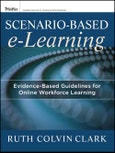Scenario-Based e-Learning
Scenario-Based e-Learning offers a new instructional design approach that can accelerate expertise, build critical thinking skills, and promote transfer of learning. This book focuses on the what, when, and how of scenario-based e-learning for workforce learning. Throughout the book, Clark defines and demystifies scenario-based e-learning by offering a practical design model illustrated with examples from veterinary science, automotive troubleshooting, sales and loan analysis among other industries. Filled with helpful guidelines and a wealth of illustrative screen shots, this book offers you the information needed to:
- Identify the benefits of a SBeL design for learners and learning outcomes
- Determine when SBeL might be appropriate for your needs
- Identify specific outcomes of SBeL relevant to common organizational goals
- Classify specific instructional goals into one or more learning domains
- Apply a design model to present content in a task-centered context
- Evaluate outcomes from SBeL lessons
- Identify tacit expert knowledge using cognitive task analysis techniques
- Make a business case for SBeL in your organization
Praise for Scenario-Based e-Learning
"Clark has done it againwith her uncanny ability to make complex ideas accessible to practitioners, the guidelines in this book provide an important resource for you to build your own online, problem-centered instructional strategies."
M. David Merrill, professor emeritus at Utah State University; author, First Principles of Instruction
"Clark's wonderful book provides a solid explanation of the how, what, and why of scenario-based e-learning. The tools, techniques, and resources in this book provide a roadmap for creating engaging, informative scenarios that lead to tangible, measurable learning outcomes. If you want to design more engaging e-learning, you need to read this book."
Karl M. Kapp, Professor of Instructional Technology, Bloomsburg University; author, The Gamification of Learning and Instruction
Table of Contents
Foreword (Frank Nguyen)
Acknowledgments
Chapter 1: What Is Scenario-Based e-Learning
Scenario-Based e-Learning: A First Look
What Do You think?
Scenario-Based e-Learning Defined
Scenario-Based vs. Directive Training Environments
What Scenario-Based e-Learning Is Not
Six Reasons to Consider Scenario-Based e-Learning Now
What Do You Think? Revisited
Coming Next
Additional Resources
Scenario-Based e-Learning and You: Why Now?
Chapter 2: When to Use Scenario-Based e-Learning
Consider Scenario-Based Learning for Strategic Tasks
What Do You Think?
Situations That Call for Scenario-Based e-Learning
Eight Scenario-Based Learning Domains
Scenario-Based Multimedia Interfaces
Meet the Scenario-Based e-Learning Samples
Coming Next
Additional Resources
Scenario-Based e-Learning and You: Your Scenario-Based e-Learning Opportunities
Chapter 3: Design of Scenario-Based e-Learning
Overview of a Scenario-Based e-Learning Design Model
Modes and Media in Scenario-Based e-Learning
Coming Next
Additional Resources
Scenario-Based e-Learning and You: Your Draft Design Model
Chapter 4: Defining Scenario Outcomes
Outcome Deliverables for Learning Domains
Assess the Complexity of your Outcome Responses
What Do You Think?
Translate Your Learning Objectives
Scenario Outcomes and Multimedia Interfaces
What Do You Think? Revisited
Coming Next
Additional Resources
Scenario-Based e-Learning and You: Translating Your Objectives
Chapter 5: Designing the Trigger Event and Case Data
What Do You Think?
Planning the Trigger Event
Defining Case Data
What Do You Think? Revisited
Coming Next
Scenario-Based e-Learning and You: Defining Your Trigger Event and Case Data
Chapter 6: Building Guidance in Scenario-Based e-Learning
What Do You Think
What Is Guidance?
Option 1: Fade Support from High to Low
Option 2: Move from Simple to Complex
Option 3: Consider Open vs. Closed Response Options
Option 4: Consider Interface/Navigation Design
Option 5: Add Training Wheels
Option 6: Incorporate Coaching and Advisors
Option 7: Embed Worksheets
Option 8: Adjust Feedback
Option 9: Make Learning Collaborative
What Do You Think? Revisited
Coming Next
Additional Resources
Scenario-Based e-Learning and You: Defining Guidance
Chapter 7: Putting the “L” in Scenario-Based e-Learning
What Do You Think?
Integrating Knowledge and Skill Resources
Tutorials
Reference
Examples
Instructors
What Do You Think? Revisited
Coming Next
Resources
Scenario-Based e-Learning and You: Defining Instructional Resources
Chapter 8: Designing Feedback and Reflection
The Power of Feedback
Learning from Mistakes
Types of Feedback
What Do You Think?
Feedback in a Nutshell
Feedback and Reflection in Learning Domains
What Do You Think? Revisited
Coming Next
Additional Resources
Scenario-Based e-Learning and You: Defining Feedback
Chapter 9: Evaluation of Scenario-Based e-Learning
What Do You Think?
Focusing Your Evaluation
Back to the Basics: Test Reliability and Validity
Test Items for Scenario-Based e-Learning
Did I Pass the Test?
Testing with Online Scenarios
What Do You Think? Revisited
Coming Next
Additional Resources
Scenario-Based e-Learning and You: Planning Your Evaluation
Chapter 10: Does Scenario-Based e-Learning Work?
Does It Work?
Is It Efficient?
Does It Motivate?
What Features Make a Difference?
What Do You Think?
Limits of Research
Discovery Learning Does Not Work
Guided Discovery Can Have Learning Advantages over “Traditional” Instruction
Learning Scaffolding Is Essential for Success
Guided Discovery Can Be More Motivating Than “Traditional” Instruction
Feedback and Reflection Promote Learning
Visual Representations Should Be Congruent with Your Learning Goals
Can Scenario-Based e-Learning Accelerate Expertise?
Research on Scenario-Based e-Learning - The Bottom Line
What Do You Think? Revisited
Coming Next
Additional Resources
Scenario-Based e-Learning and You: Evidence-Based Decisions
Chapter 11: Eliciting Critical Thinking Skills for Scenario-Based e-Learning
What Is Knowledge Elicitation?
What Do You Think?
Three Approaches to Knowledge Elicitation
Which Elicitation Method Should You Use?
Types of Knowledge and Skill to Elicit
Incorporating Critical Thinking Skills into Your Lessons
Guidelines for Success
What Do You Think? Revisited
Coming Next
Additional Resources
Scenario-Based e-Learning and You: Eliciting Tacit Knowledge
Chapter 12: Implementing Scenario-Based e-Learning
What Do you Think?
Four Steps to Project Success
Step One: Present a Strong Business Case
Step Two: Plan Your Project
Step Three: Design Your Approach
Step Four: Develop Your First Scenario
What Do You Think? Revisited
Coming Next: Your Scenario-Based e-Learning Project
Additional Resources
Scenario-Based e-Learning and You: Planning Your Implementation
Appendix A: An Introduction to the Scenario-Based e-Learning Examples
Appendix B: Repeated Figures
Appendix C: Reliability and Validity for Learning Measures for Scenario-Based e-Learning
List of Figures and Tables
Glossary
References
About the Author
Index








